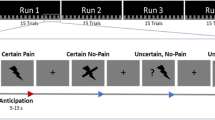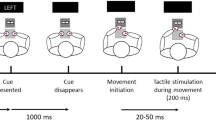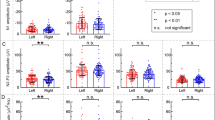Abstract
Recent studies have suggested that the threat of pain may redirect attention towards specific features of the pain stimulus via attentional control settings. For instance, it has been shown that anticipating pain results in attentional prioritization of the location where pain is expected. In contemporary theories on attention and pain, it has been argued that pain control motivation—e.g., attempting to avoid pain—is capable of enhancing these effects. The present study investigated if the threat of pain prioritizes attention towards somatosensory input over other sensory information, and if pursuing a pain control goal augments this effect. In a Temporal Order Judgment experiment, 41 participants were presented with visuo-tactile stimulus pairs and asked to judge which stimulus they had perceived first. Half of all trials were associated with the threat of acute pain, while the other half was not. Furthermore, half of our sample was encouraged to avoid the administration of pain by means of a specified behavioral response, whereas the other half was not. In line with our hypotheses, we found the threat of pain to prioritize attention towards the somatosensory modality, i.e., participants tended to perceive the tactile stimulus as occurring earlier in time than the visual stimulus. Interestingly, in-depth analyses suggested that this effect was predominantly carried by participants who were engaged in pain control efforts. These findings support the idea that pain goals exert top–down attentional control prioritizing pain-relevant sensory information. Clinical relevance and future directions are discussed.



Similar content being viewed by others
References
Alcalá-Quintana, R., & García-Pérez, M. A. (2013). Fitting model-based psychometric functions to simultaneity and temporal-order judgment data: MATLAB and R routines. Behavior Research Methods, 45, 972–998. doi:10.3758/s13428-013-0325-2.
Bar-Haim, Y., Lamy, D., Pergamin, L., Bakermans-Kranenburg, M. J., & van Ijzendoorn, M. H. (2007). Threat-related attentional bias in anxious and nonanxious individuals: A meta-analytic study. Psychological Bulletin, 133(1), 1–24. doi:10.1037/0033-2909.133.1.1.
Bates, D., Maechler, M., Bolker, B., & Walker, S. (2014). lme4: Linear mixed-effects models using S4 classes. R package version 1.1-6. R. http://cran.r-project.org/package=lme4
Chapman, C. R., Tuckett, R. P., & Song, C. W. (2008). Pain and stress in a systems perspective: Reciprocal neural, endocrine, and immune interactions. Journal of Pain, 9(2), 122–145. doi:10.1016/j.jpain.2007.09.006.
Crombez, G., Van Damme, S., & Eccleston, C. (2005). Hypervigilance to pain: An experimental and clinical analysis. Pain, 116(1–2), 4–7. doi:10.1016/j.pain.2005.03.035.
Crombez, G., Van Ryckeghem, D. M. L., Eccleston, C., & Van Damme, S. (2013). Attentional bias to pain-related information: A meta-analysis. Pain, 154(4), 497–510. doi:10.1016/j.pain.2012.11.013.
De Ruddere, L., Goubert, L., Stevens, M., de C Williams, A. C., & Crombez, G. (2013). Discounting pain in the absence of medical evidence is explained by negative evaluation of the patient. Pain, 154(5), 669–676. doi:10.1016/j.pain.2012.12.018.
Durnez, W., & Van Damme, S. (2015). Trying to fix a painful problem: The impact of pain control attempts on the attentional prioritization of a threatened body location. The Journal of Pain, 16(2), 135–143.
Eccleston, C., & Crombez, G. (1999). Pain demands attention. Psychological Bulletin, 125(3), 356–366.
Eccleston, C., & Crombez, G. (2007). Worry and chronic pain: A misdirected problem solving model. Pain, 132(3), 233–236. doi:10.1016/j.pain.2007.09.014.
Folk, C. L., & Remington, R. W. (2008). Bottom-up priming of top-down attentional control settings. Visual Cognition, 16(2–3), 215–231. doi:10.1080/13506280701458804.
Hayes, S. C., Luoma, J. B., Bond, F. W., Masuda, A., & Lillis, J. (2006). Acceptance and commitment therapy: Model, processes and outcomes, 44, 1–25. doi:10.1016/j.brat.2005.06.006
Holm, S. (1979). A simple sequentially rejective multiple test procedure. Scandinavian Journal of Statistics, 6(2), 65–70.
Jia, L., Shi, Z., Zang, X., & Müller, H. J. (2013). Concurrent emotional pictures modulate temporal order judgments of spatially separated audio-tactile stimuli. Brain Research, 1537, 156–163. doi:10.1016/j.brainres.2013.09.008.
Legrain, V., Van Damme, S., Eccleston, C., Davis, K. D., Seminowicz, D. A., & Crombez, G. (2009). A neurocognitive model of attention to pain: Behavioral and neuroimaging evidence. Pain, 144(3), 230–232. doi:10.1016/j.pain.2009.03.020.
Moskowitz, G. B. (2002). Preconscious effects of temporary goals on attention. Journal of Experimental Social Psychology, 38, 397–404. doi:10.1016/S0022-1031(02)00001-X.
Notebaert, L., Crombez, G., Vogt, J., De Houwer, J., Van Damme, S., & Theeuwes, J. (2011). Attempts to control pain prioritize attention towards signals of pain: An experimental study. Pain, 152(5), 1068–1073. doi:10.1016/j.pain.2011.01.020.
Öhman, A. (1979). The orienting response, attention and learning: an information-processing perspective. In Kimmel H.D., Van Olst E.H. & Orlebeke J.F. (Eds.) The orienting reflex in human (pp. 55–80). Hillsdale: Erlbaum.
Rollman, G. B. (2009). Perspectives on hypervigilance. Pain, 141(3), 183–184. doi:10.1016/j.pain.2008.12.030.
Sinke, C., Schmidt, K., Forkmann, K., & Bingel, U. (2015). Phasic and tonic pain differentially impact the interruptive function of pain. PLoS One, 10(2), 1–13. doi:10.1371/journal.pone.0118363.
Spence, C., Baddeley, R., Zampini, M., James, R., & Shore, D. I. (2003). Multisensory temporal order judgments: When two locations are better than one. Perception and Psychophysics, 65(2), 318–328. doi:10.3758/BF03194803.
Spence, C., Bentley, D. E., Phillips, N., McGlone, F. P., & Jones, A. K. (2002). Selective attention to pain: A psychophysical investigation. Experimental Brain Research, 145(3), 395–402. doi:10.1007/s00221-002-1133-6.
Spence, C., & Parise, C. (2010). Prior-entry: A review. Consciousness and Cognition, 19(1), 364–379. doi:10.1016/j.concog.2009.12.001.
Spence, C., Shore, D. I., & Klein, R. M. (2001). Multisensory prior entry. Journal of Experimental Psychology: General, 130(4), 799–832.
Stein, B. E., & Stanford, T. R. (2008). Multisensory integration: current issues from the perspective of a single neuron. Nature Reviews Neuroscience, 9, 255–266.
Sullivan, M. J. L., Bishop, S., & Pivik, J. (1995). The pain catastrophizing scale: Development and validation. Psychological Assessment, 7, 524–535.
Titchener, E. B. (1908). Lectures on the elementary psychology of feeling and attention. New York: Macmillan.
Van Damme, S., Crombez, G., Bijttebier, P., Goubert, L., & Van Houdenhove, B. (2002). A confirmatory factor analysis of the Pain Catastrophizing Scale: Invariant factor structure across clinical and non-clinical populations. Pain, 96, 319–324. Accessed Feb 7, 2014 from http://www.sciencedirect.com/science/article/pii/S0304395901004638
Van Damme, S., Crombez, G., Eccleston, C., & Goubert, L. (2004). Impaired disengagement from threatening cues of impending pain in a cross modal cueing paradigm. European Journal of Pain, 8(3), 227–236. doi:10.1016/j.ejpain.2003.08.005.
Van Damme, S., Crombez, G., Wiech, K., Legrain, V., Peters, M. L., & Eccleston, C. (2009a). Why become more general when we can be more specific? Comment on Hollins et al. “Perceived intensity and unpleasantness of cutaneous and auditory stimuli: an evaluation of the generalized hypervigilance hypothesis” [Pain 2009; 141:215–221], and on Rollman. Pain, 144(3), 342–343. doi:10.1016/j.pain.2009.04.035. (author reply 343–4).
Van Damme, S., Gallace, A., Spence, C., Crombez, G., & Moseley, G. L. (2009b). Does the sight of physical threat induce a tactile processing bias? Modality-specific attentional facilitation induced by viewing threatening pictures. Brain Research, 1253, 100–106. doi:10.1016/j.brainres.2008.11.072.
Van Damme, S., Legrain, V., Vogt, J., & Crombez, G. (2010). Keeping pain in mind: A motivational account of attention to pain. Neuroscience and Biobehavioral Reviews, 34(2), 204–213. doi:10.1016/j.neubiorev.2009.01.005.
Vanden Bulcke, C., Crombez, G., Spence, C., & Van Damme, S. (2014). Are the spatial features of bodily threat limited to the exact location where pain is expected? Acta Psychologica, 153, 113–119. doi:10.1016/j.actpsy.2014.09.014.
Vanden Bulcke, C., Van Damme, S., Durnez, W., & Crombez, G. (2013). The anticipation of pain at a specific location of the body prioritizes tactile stimuli at that location. Pain, 154(8), 1464–1468. doi:10.1016/j.pain.2013.05.009.
Verbruggen, F., & Aron, A. R. (2010). Theta burst stimulation dissociates attention and action updating in human inferior frontal cortex. Proceedings of the National Academy of Sciences, 107(31), 13966–13971. doi:10.1073/pnas.1001957107.
Weinstein, S. (1968). Intensive and extensive aspects of tactile sensitivity as a function of body part, sex and laterality. In Kenshalo D. R. (Ed.), The Skin Senses (pp. 195–200). Springfield: Thomas.
Welch, R. B., & Warren, D. H. (1980). Immediate perceptual response to intersensory discrepancy. Psychological Bulletin, 88(3), 638–667. doi:10.1037/0033-2909.88.3.638.
Acknowledgments
This study was supported by a research Grant (BOF11/STA/004) by the Special Research Foundation of Ghent University (BOF) awarded to S. Van Damme. The authors wish to thank Anand Ramamoorthy for carefully proofreading the manuscript, and Iege Bassez for valuable help with the data collection.
Author information
Authors and Affiliations
Corresponding author
Ethics declarations
Conflict of interest
There are no conflicts of interest that may arise as a result of this research.
Electronic supplementary material
Below is the link to the electronic supplementary material.
Rights and permissions
About this article
Cite this article
Durnez, W., Van Damme, S. Let it be? Pain control attempts critically amplify attention to somatosensory input. Psychological Research 81, 309–320 (2017). https://doi.org/10.1007/s00426-015-0712-7
Received:
Accepted:
Published:
Issue Date:
DOI: https://doi.org/10.1007/s00426-015-0712-7




